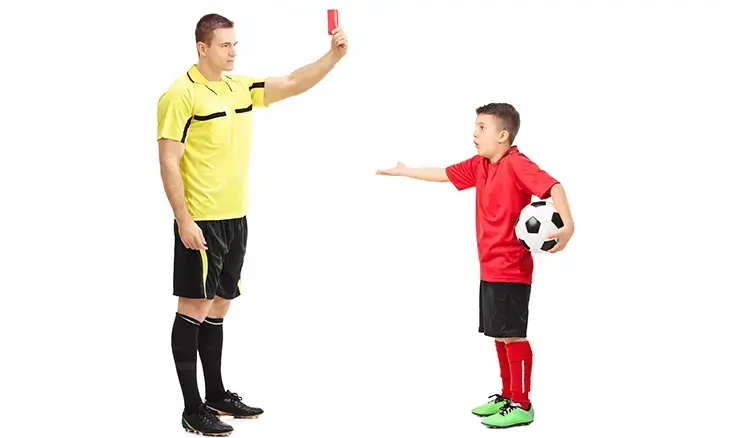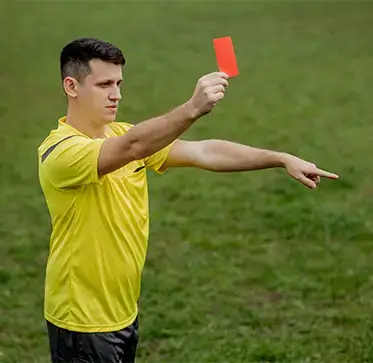CRFC BLOGS
LATEST BLOGS & NEWSLETTERS
Soccer Red Card Rules
Red Card in Soccer
Importance of Red Cards in Youth Soccer
In youth soccer, a red card signifies that a player has committed a serious violation that warrants immediate removal from the game. The purpose of this rule is to uphold the integrity of the game by discouraging dangerous or unsportsmanlike behavior. Youth soccer leagues take these rules very seriously because they are designed to protect young players and maintain a positive environment.
Issuing a red card in youth soccer can be a defining moment in a game. It affects the player who receives it and has significant implications for their team. Playing with one less player can be a disadvantage, making it all the more important for players to understand what actions could lead to a red card.
Common Offenses Leading to a Red Card
Serious Foul Play
- Serious foul play is one of the most common reasons a player might receive a red card in youth soccer. This type of offense usually involves actions that are dangerous or reckless and have the potential to injure another player. Examples include overly aggressive tackles, especially those made with excessive force, and challenges that put the safety of an opponent at risk. For instance, if a player slides into a tackle with their studs up and makes contact with another player’s legs, the referee will likely show a red card for serious foul play.
- In youth soccer, referees are particularly careful about serious foul play because young players are still learning and developing their skills. Coaches and parents should emphasize the importance of playing safely and remind young athletes that the game should be played moderately, with safety as the top priority, even if it means not winning.
Violent Conduct
- Violent conduct is another primary reason why a player might be shown a red card. This term refers to any physical aggression that goes beyond what is acceptable in the game. Examples include punching, kicking, or striking another player, referee, or spectator. Violent conduct is one of the most severe offenses in soccer, and referees are instructed to apply a zero-tolerance policy when dealing with it.
- In youth soccer, teaching players how to manage their emotions on the field is crucial. The game’s intensity can sometimes lead to frustration or anger, but young players must learn to channel these emotions positively. Coaches play a vital role by demonstrating calm behavior and teaching players to stay focused on the game, even when things are not going their way.
Denying a Goal-Scoring Opportunity
- A player can also receive a red card for denying an obvious goal-scoring opportunity by committing a foul or using their hand (except for the goalkeeper within their penalty area) to stop the ball from going into the goal. This type of offense is considered highly unacceptable because it directly affects the game’s fairness. For example, if a defender deliberately uses their hand to stop the ball from crossing the goal line, the referee will almost certainly show a red card.
- This rule is essential for maintaining fair play in youth soccer. Players should understand that losing is better than breaking the rules to avoid defeat. Coaches and parents can help by reinforcing the importance of honesty and integrity, both on and off the field.

Offensive, Insulting, or Abusive Language
- Another reason a player might receive a red card is for using offensive, insulting, or abusive language. This includes any language that is deemed disrespectful or inappropriate by the referee, whether directed at another player, a referee, or anyone else involved in the game. Youth soccer emphasizes sportsmanship, and verbal abuse is not tolerated.
- Young players need to recognize the impact their words can have on others. Encouraging positive communication and teaching players to express themselves respectfully, even during tense moments, can help prevent situations that might lead to a red card.
Second Yellow Card
- In soccer, a player who receives two yellow cards in the same game is automatically shown a red card. The yellow card serves as a warning, and getting a second one indicates that the player has continued to break the rules. This could include repeated fouling, ongoing dissent, or unsportsmanlike behavior.
- Young players must understand the consequences of accumulating yellow cards. While the first yellow card is a warning, the second will have serious consequences for the player and their team. Coaches can support their players by ensuring they understand the rules and encouraging them to play within the game’s boundaries.
Consequences of Receiving a Red Card
Immediate Consequences
Being Sent Off from the Game
The most immediate consequence of receiving a red card is the player leaving the game immediately. When a player is shown a red card, they must leave the field immediately. This means they cannot participate in the rest of the match, and their team has to continue with one fewer player.
For the player involved, being sent off can be a tough experience, but it’s also an opportunity to learn. Coaches and parents should offer support and help the player reflect on what happened, guiding them on how to avoid similar situations in the future.
Impact on Team Strategy
When a player receives a red card, their team is left with one less player on the field, which can significantly affect the team’s strategy. Playing with fewer players makes it more difficult to defend against the opposing team and to maintain control of the game. As a result, teams often have to adopt a more defensive approach to make up for the loss.
This situation can teach all players involved an important lesson about discipline and how one person’s actions can impact the entire team. Coaches should use these moments to emphasize the importance of teamwork and the need for every player to stay focused and committed to the rules.

Post-Match Consequences
Suspension from Subsequent Games
In addition to being sent off during the game, a player who receives a red card is usually suspended from playing in the next match. The length of the suspension can vary depending on the seriousness of the offense and the specific rules of the league. For example, violent conduct might result in a longer suspension than serious foul play.
This suspension acts as a further discouragement against bad behavior, highlighting the importance of playing within the rules. It also gives the player time to think about their actions and learn the value of self-control and sportsmanship.
Additional Disciplinary Actions
In some cases, particularly severe offenses can lead to additional disciplinary actions beyond a simple suspension. This could include longer suspensions, fines, or even a requirement to attend a disciplinary hearing. These actions are intended to address the most serious rule violations and to ensure that all players, coaches, and parents understand the seriousness of such offenses.
For youth soccer players, these additional penalties are rare but serve as a reminder of the responsibilities that come with playing the game. It’s important for young athletes to understand that their actions on the field can have lasting consequences, both for themselves and for their team.
Best Practices for Avoiding Red Cards
Encouraging Sportsmanship
Promoting Fair Play
One of the most effective ways to avoid red cards is by promoting fair play. This means teaching players to respect the rules, their opponents, and the referees. Encouraging good sportsmanship from an early age helps prevent behaviors that could lead to a red card.
Coaches and parents should consistently emphasize the importance of fair play. This includes praising positive behavior and addressing any issues as soon as they arise. By doing this, players can develop a strong respect for the game and its rules.
Understanding the Rules
Another important factor in avoiding red cards is making sure players clearly understand the rules of the game. This includes knowing which actions could result in a red card and why these actions are not allowed. When players are familiar with the rules, they are less likely to accidentally commit offenses that could get them sent off.
It’s beneficial to give players regular opportunities to learn and review the rules. This could involve watching game footage, discussing different scenarios, or simply going over the rulebook together.

Role of Coaches and Parents
Guiding Young Players
Coaches and parents play a crucial role in guiding young players. They should work together to teach children how to manage their emotions, handle pressure, and make good decisions on the field. By setting clear expectations and offering consistent support, they can help players deal with the challenges of the game without engaging in behavior that might lead to a red card.
Open communication is key. Coaches and parents should encourage players to ask questions, express their concerns, and share their experiences. This helps create a positive, supportive environment where players feel safe and motivated to improve.
Addressing Misconduct Early
Addressing potential misconduct early can prevent it from escalating into a situation that results in a red card. Coaches should be proactive in managing their players’ behavior, using their authority to deal with issues before they become serious. This might involve pulling a player aside for a quick talk or making a substitution to give the player time to calm down.
Parents can also contribute by discussing the importance of good behavior with their children before and after games, reinforcing the lessons learned on the field.

Conclusion
Understanding the red card rules in youth soccer is essential for everyone involved in the sport. By knowing the common offenses, the consequences of receiving a red card, and the best practices for avoiding one, players, coaches, and parents can work together to ensure a safe and enjoyable experience for all. Youth soccer is about more than just winning; it’s about learning, growing, and playing the game with respect and integrity. As we guide young players through their soccer journey, it’s important to remember that the lessons they learn on the field—about discipline, teamwork, and respect—will stay with them.
FAQs
What happens when a player receives a red card in youth soccer?
When a player receives a red card in youth soccer, they must leave the field immediately and cannot return to the game. Their team must continue playing with one fewer player, which can make the game more challenging for the remaining players.
What offenses can lead to a red card in youth soccer?
A player can receive a red card for serious offenses like dangerous tackles, violent conduct, using offensive language, or intentionally stopping a clear goal-scoring opportunity. These actions are considered severe because they can harm other players or disrupt the fairness of the game.
Can a player play in the next game after receiving a red card?
No, a player who receives a red card is usually suspended from the next match. The suspension can be longer if the offense was particularly serious, such as for violent conduct.
How can players avoid getting a red card in youth soccer?
Players can avoid red cards by understanding the rules, showing respect to opponents and referees, and playing fairly. Coaches and parents should reinforce the importance of good sportsmanship and following the rules of the game.
What should parents do if their child receives a red card?
If a child receives a red card, parents should focus on helping them learn from the experience. Encourage them to reflect on what happened, discuss the importance of following the rules, and support them in improving their behavior in future games.

Did you find this useful?


